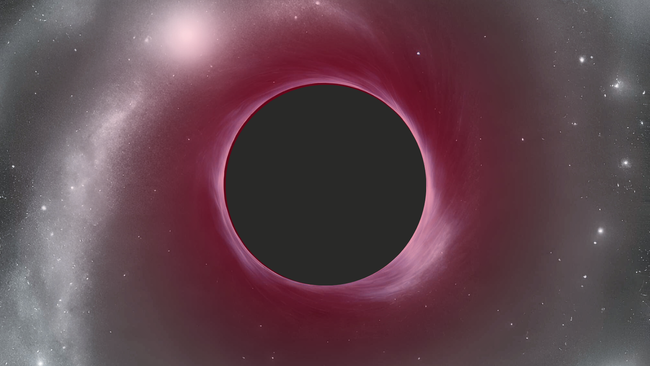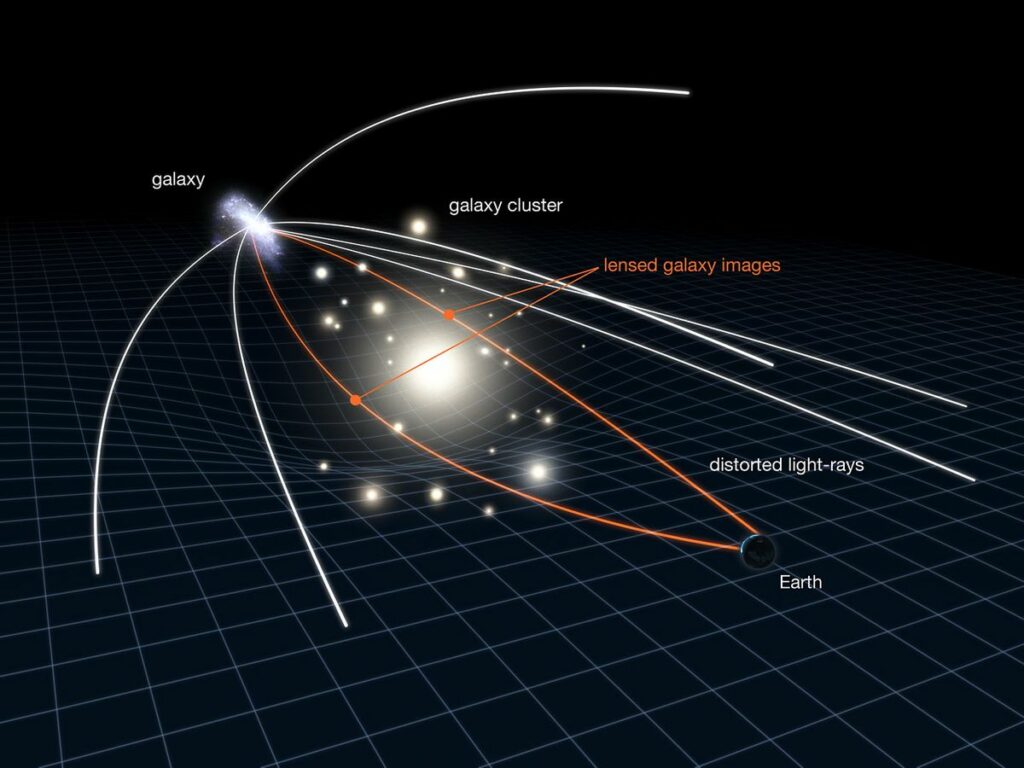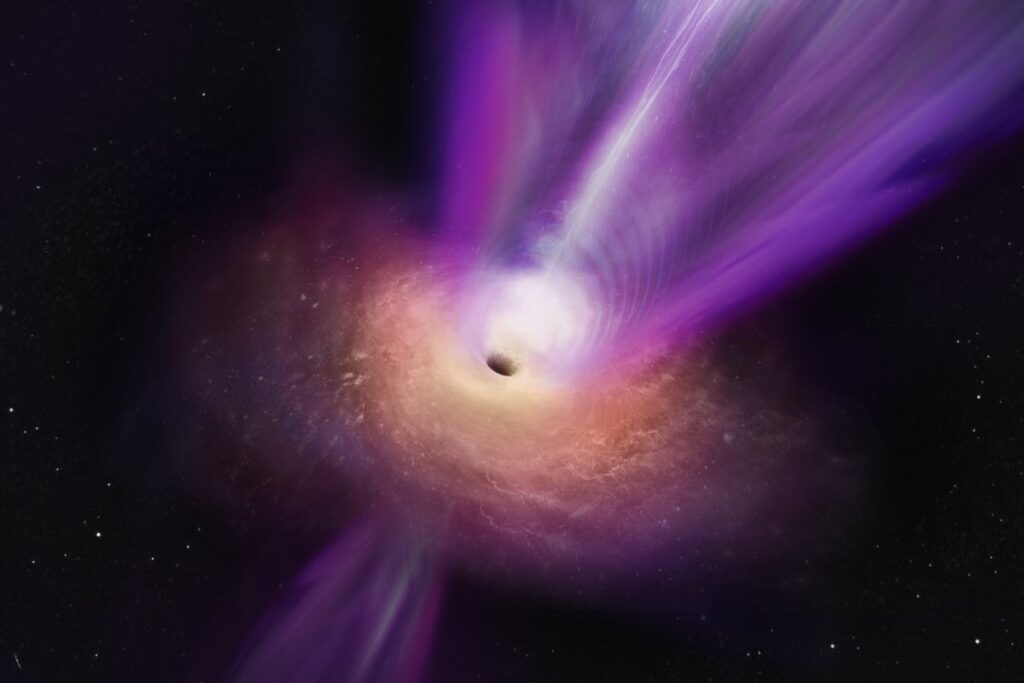The early universe witnesses the discovery of an ‘extremely red’ supermassive black hole by the James Webb Space Telescope.
The supermassive black hole is 40 million times the mass of the sun and fuels a quasar that formed 700 million years post the Big Bang.

The James Webb Space Telescope (JWST) has enabled astronomers to identify a supermassive black hole with an “extremely red” appearance that is growing in the early universe. The red color of the black hole, observed approximately 700 million years post-Big Bang, is a consequence of the universe’s expansion. Due to the universe’s expansion in all directions, light heading towards us becomes “redshifted,” with the redshifted light in this instance indicating a veil of dense gas and dust enveloping the black hole.
Through the analysis of JWST data, the team of astronomers led by Lukas Furtak and Adi Zitrin from Ben-Gurion University of the Negev was able to ascertain the mass of the supermassive black hole. At roughly 40 million times the mass of the sun, it is surprisingly massive when compared to the galaxy it is situated in.
The group additionally discovered that the supermassive black hole, situated roughly 12.9 billion light-years away from Earth, is actively consuming the gas and dust in its vicinity. Essentially, it is expanding.
“We were thrilled upon receiving the initial data from JWST. While analyzing the data delivered for the UNCOVER initiative, we noticed three extremely compact yet vividly red objects that particularly drew our attention,” Furtak mentioned in a press release. “The ‘red-dot’ resemblance right away made us consider the possibility of it being a quasar-like entity.”
The ‘three red dots’
Quasars form when significant amounts of matter encircle supermassive black holes, such as the one described. This material creates an accretion disk consisting of gas and dust that gradually supplies the black hole. The immense gravitational pull of the black hole stirs up this material, resulting in high temperatures and causing it to emit light.
Moreover, any matter that doesn’t get absorbed by the supermassive black hole is directed towards the poles of the cosmic giant. Particles in these areas are accelerated to nearly the speed of light, forming highly focused jets. These relativistic jets produce bright electromagnetic emissions when they are expelled.
Due to these processes, quasars fueled by supermassive black holes in active galactic nuclei (AGN) are often incredibly luminous, surpassing the combined light output of all stars in the surrounding galaxy.
The significant radiation emanating from around this specific supermassive black hole led to its appearance as a small point in JWST data.
Rachel Bezanson, a co-lead of the UNCOVER program from the University of Pittsburgh, mentioned in a statement that the object’s colors indicated it was not a typical star-forming galaxy, further supporting the supermassive black hole theory. Despite being distinct from other quasars discovered during that period, its compact size strongly suggested it was a supermassive black hole.
The early quasar would have remained invisible even to the powerful infrared capabilities of the JWST if not for an effect predicted by Albert Einstein in 1915.
Einstein’s lens
Einstein’s theory of general relativity posits that objects with mass distort the fabric of space and time, which are combined into a single entity known as “spacetime.” According to the theory, gravity is a result of this distortion. The more massive an object is, the more pronounced the distortion of spacetime becomes.
This distortion not only influences the movement of planets around stars and stars around the centers of their galaxies, but it also alters the paths of light emitted by those stars. As light travels closer to a massive object, its trajectory becomes more curved. Consequently, light from a single background object can be bent by a foreground object, known as a “lensing object,” causing the background object to appear in different locations in the sky. In some cases, the background object may even appear magnified due to this effect.
This optical phenomenon is referred to as “gravitational lensing.”

We employed a numerical lensing model that we had developed for the galaxy cluster to establish that the three red dots must be multiple images of the same background source, observed when the universe was just around 700 million years old,” Zitrin stated.
Version 1: We utilized a numerical lensing model that we had created for the galaxy cluster to ascertain that the three red dots had to be multiple images of the same background source, observed when the universe was merely about 700 million years old,” Zitrin mentioned.

Upon further examination of the background source, it was determined that the light emitted must have originated from a compact area. According to Jenny Greene, a researcher from Princeton University, the entire light output of the galaxy could be contained within a small region comparable to a present-day star cluster. The gravitational lensing effect allowed for precise measurements of the size of the source. Even with all the stars packed into such a confined space, the black hole still accounted for at least 1% of the system’s total mass.
This discovery deepens the enigma surrounding the growth of supermassive black holes, which can reach sizes millions or even billions of times greater than that of the sun, during the early stages of the universe. Greene noted that several other supermassive black holes from the early universe exhibit similar characteristics, shedding light on the complex relationship between black hole and host galaxy growth, a phenomenon that remains poorly understood.
The James Webb Space Telescope (JWST) has identified numerous “little red dots” over time, potentially indicating the presence of supermassive black hole-powered quasars in the early universe. This discovery offers hope that the longstanding mystery of rapid black hole growth could soon be unraveled.
Zitrin likened this situation to the astrophysical version of the chicken and egg dilemma, highlighting the uncertainty surrounding the sequence of events – whether the galaxy or black hole formed first, the initial mass of the earliest black holes, and the mechanisms behind their growth.
The team’s research was published on Feb. 14 in the journal Nature.
Do not forget to share your opinion with us to provide you with the best posts !



0 Comments